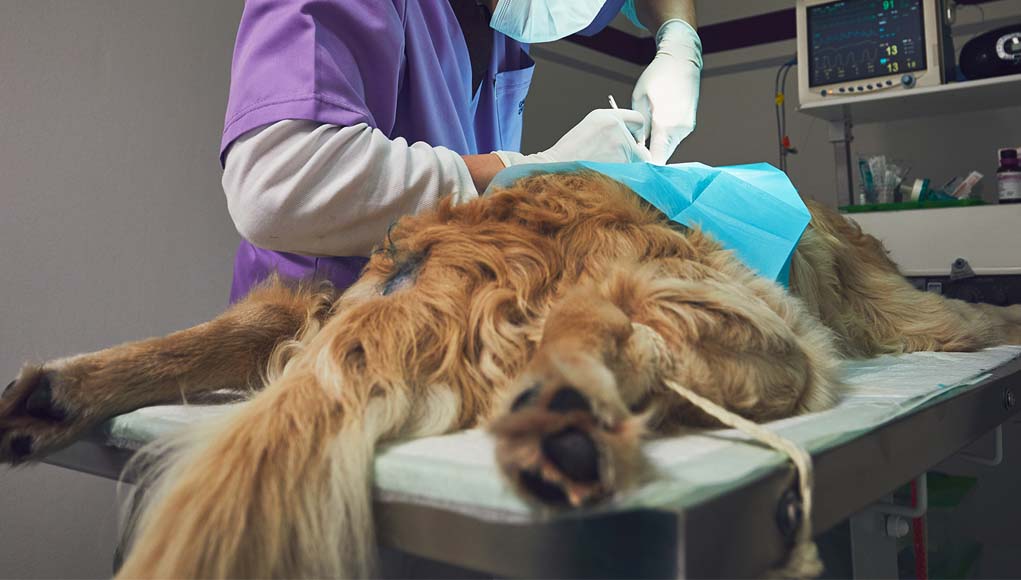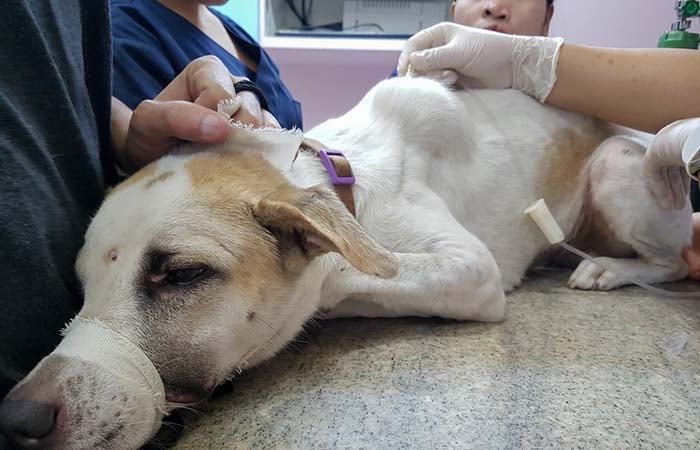Table of Contents
The greatest nightmare of any dog owner is that the dog may get a tumor.
While some of them are benign, there are plenty of tumors that could be deadly.
This fear became so widespread that only mentioning the word “tumor” causes people to feel frightened, lost, and confused.
Fortunately, in this article, we'll discuss how to shrink a tumor in a dog and what you must know about the process.
Types of Tumors in Dogs
There are many different types of dog tumors.
The main difference is whether it is malignant (cancerous) or benign, and on the surface, both types may look alike.
If you go over your dog’s body and feel something that seems like a lump or a skin excess, it's time to take your dog to the vet’s office.
These bumps are easy to notice, especially because they often are of pink or red color, and they are quite solid under our fingers.
Statistically, the greater majority of skin cancers in dogs are benign (while in cats, the majority are cancerous), according to Merck Vet.
Thus, avoid stressing too much about it before you consult with a vet.
Some breeds are also more likely to have benign tumors, while others are more likely to have malignant ones.
For example, a 2016 study found that small breeds statistically have benign tumors.
Most benign tumors were found in five breeds: Yorkshire terrier, Maltese, Poodle, Shih Tzu, and Dachshund.
While some other breeds (statistically, large breeds are more likely to have cancerous ones) tend to have malignant tumors, and that was most prevalent in these seven breeds: Labrador retriever, Welsh corgi, Shiba, Shetland sheepdog, Chihuahua, Beagle, and Bernese mountain dog.
Age seems to play a factor as well in how often the tumor is malignant or benign:
Regardless of what breed you have, when you find a skin abnormality, do not assume that it's not cancerous and ignore it.
Consult with a vet because even benign tumors can become malignant in the future.
This is why the vet will often suggest shrinking it or removing it regardless, either because it has the potential to become malignant or simply because it lowers the quality of your dog’s life.
Here are some of the options on how to shrink a tumor in a dog and/or remove it.
How to Shrink a Tumor in a Dog (or Remove It)
1. Chemotherapy
This is one of the most popular methods for shrinking tumors in dogs, just as it is in humans.
The very reason for the widespread use of this method is its efficiency.
However, that also depends on the type of cancer.
For example, when it comes to cancers such as thyroid carcinoma in dogs, a 2011 study found that surgery alone was enough, and including chemotherapy in the pet's treatment plan did not improve the results at all.
For most skin cancers in dogs, this remains a popular treatment option.
Chemotherapy is most commonly used for malignant tumors, but it can also be applied to benign ones that significantly impact your dog’s life.
This therapy consists of a variety of drugs that have the ability to kill malignant cells and shrink the tumor in this way.
However, the type of chemotherapy and the drugs that will be used on a dog varies based on the dog’s breed, age, health, and immunity.
If the dog doesn’t react very well to one type, the oncologist can quickly change it to the other.
A 2017 study found that a common reason why dog owners refuse this therapy is for fear of side effects.
This is understandable since it can really cause a wide array of things, such as vomiting, diarrhea, drop in white blood cell count, fur thinning, loss of weight, energy loss, or skin irritation.
However, if it comes to the point that the vet suggests chemo, remember that it is not a death sentence.
Wisconsin Veterinary Referral Center emphasizes that dogs, and animals in general, cope with chemotherapy much better than humans, and they experience fewer side effects, and sometimes there are no prominent side effects at all.
Also, they mention that the goal here is improving life longevity and quality of life, and not complete removal of the tumor, unlike the therapy for people with cancer.
Chemotherapy will usually be prescribed for tumors such as mast cell tumors, melanoma, or hemangiosarcoma.
2. Radiation
Radiation is used for shrinking the tumors by targeting precisely the place where the dog's tumor is located.
This therapy can be very aggressive and very useful for your dog.
It is performed on the machines which emit the beams of photons.
Once the tumor is localized, the beam is directed into it.
After it hits the malignant cells, radiation breaks the DNA chain, disabling the cells from multiplying and the tumor from spreading.
Additionally, the bad cells break down, and the dog’s body is able to remove them from the organism.
A pet owner's anxiousness arises again from the possible side effects.
Still, a 2009 study and a recent 2019 study both found that for the majority of owners, this was a worthwhile decision, and they would recommend it.
Obviously, radiation can affect the surrounding skin and healthy tissue; it provokes rashness and redness, as well as fur thinning.
Yet, remember that these are only temporary side effects, and once cured, your dog will return to its old self.
Also, you should know that, similarly to chemotherapy, there is a possibility that your dog won’t have any significant side effects from radiation treatment.
The only difference between radiation on people and dogs is that on dogs, it has to be performed with anesthesia because they move a lot and they need to hold still while the beam is directed into a tumor.
This method is often used for liposarcoma, mastocytoma, or osteosarcoma in dogs, and there is a very good chance that the tumor will shrink significantly after this therapy.
3. Surgery and/or Amputation
Tumors in dogs can be surgically removed with or without amputation, depending on individual cases.
Obviously, the latter is preferred, and amputation itself must sound to you like a very invasive technique when it comes to figuring out how to shrink a tumor in a dog.
However, in the case when the whole limb or part of the body is attacked by cancerous cells, the vet will probably suggest this method.
The cancer is localized, the plan is made, and the affected part is removed while your dog is under anesthesia.
It is also a very efficient plan in case when you need to shrink cancer rapidly, as it already metastasized to different parts of the body.
The vet will cut it off from the body parts where it is possible to remove it surgically and focus on more delicate places where more complex treatment is required.
Amputation can be applied for osteosarcoma or liposarcoma. However, in some rare cases, the surgery can also be recommended in the case of a benign tumor such as lipoma.
Lipoma is a fatty tissue that doesn’t directly endanger your dog’s life but may be preventing your pooch from walking or moving altogether.
Thus, this becomes a routine surgery, and after this, your dog will be on his feet in no time.
Even if your dog needs an amputation, consider the fact that just because people take it badly doesn’t mean that dogs do.
In fact, dogs don’t have the same amount of psychological burden that comes with an amputation that we do.
Therefore, it has been recorded that dogs have speedy recovery afterward, especially if you surround them with love and care.
Get them a dog wheelchair if needed – your pup won't mind.
4. Calcium Chloride in Alcohol
If previous options are too expensive, this is by far the most affordable one.
Bear in mind that it can work only on some tumors in dogs, and it has to be suggested and administered by a veterinarian.
This formula is used for non-surgical castration of dogs in a way that it can shrink testes, and a 2014 study found it to be very promising.
Interestingly, by the same token, scientists have noticed that this solution can also shrink tumors when injected directly into them.
Although it is usually applied on benign bumps, this method can relieve your dog of pain or unnecessary trouble, and an old 1985 study found it to be very effective.
The advantage of this method is that it doesn’t require anesthesia, and it will spare you anxiety and fear, which regular surgeries bring.
The disadvantage is that (a) while it is effective, it may not work for many tumor types in dogs and/or not be as effective as some above methods; (b) it causes irritation and skin necrosis in dogs, according to a 2012 study.
The result of this injection is commonly a regression of a benign tumor.
In Summary
 Tumors in dogs can be scary, and every owner would rather avoid them.
Tumors in dogs can be scary, and every owner would rather avoid them.
However, if your dog gets diagnosed with a tumor, it’s easier if you know that there are various ways to shrink it.
The most effective options when it comes to deciding on how to shrink a tumor in a dog are chemo, radiation, surgery or amputation, or some alternative method such as injecting a chemical solution.
Whatever may come, bear in mind that our dogs cope with these therapies much better than people.
If you follow your vet’s advice and ensure the best care for your dog, he can come out of this as a winner and have a long life ahead of him.


















